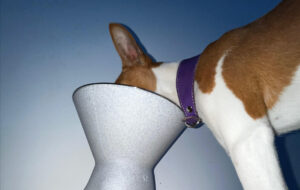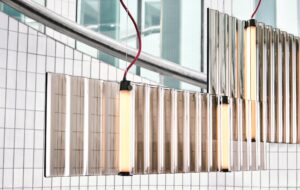


words Bill Millard
The opening night gala at the Guthrie Theatre featured a Jean Nouvel impersonator.
Clad in the French architect’s trademark black and capering among parasol-twirling chorus girls, he delivered a spot-on parody of the “Major-General’s Song” from The Pirates of Penzance, reworked to portray Nouvel as “the very model of a modern major architect”.
It probably wasn’t lost on the theatre-savvy audience that Arthur Sullivan’s original lyrics hadn’t exactly showered the Major-General with compliments. Given the long, controversial process of replacing Minneapolis’ beloved original Guthrie with Nouvel’s stark design, it is possible that playwright Jeffrey Hatcher and artistic director Joe Dowling were either affectionately sending up a friend or getting in a bit of a dig.
The fit between Nouvel and Minneapolitans could easily appear counterintuitive and uneasy. The American Midwest is one of the least francophilic places in the world. One resident spoke of a general feeling that the French weren’t “predisposed to being in tune with what people want; they’re more [inclined to say] ‘This is our creation, this is our aesthetic; to hell with you.’” At the design’s unveiling, some had found it simply ugly. “Sexy-ugly,” said Christopher Hawthorne in the Los Angeles Times – but that’s not a local view. While Minneapolis takes its role as a regional arts centre seriously, it is not a natural home for highly theoretical positions. The dominant tone of conversations there is practical and reticent, not abstract and flamboyant.
Minneapolis is one of the best-kept secrets in the nation, with some 100 theatre groups, 57 museums, the country’s largest Fringe Festival, more theatre seats per capita than anywhere outside New York and five new major cultural buildings: the Guthrie, Cesar Pelli’s Minneapolis Public Library, Michael Graves and Associates’ Minneapolis Institute of Arts and Children’s Theatre Company, and the expanded Walker Arts Centre by Herzog & de Meuron. That’s half a billion dollars’ worth of new arts infrastructure since April 2005. Nouvel’s new Guthrie is the strangest, and in several ways riskiest, of all these projects. It replaces the Ralph Rapson building where Anglo-Irish director Tyrone Guthrie launched a resolutely anti-commercial regional theatre in 1963. Audiences and performers had strong loyalties to Rapson’s cubic box and asymmetrical thrust stage. One “Save the Guthrie” activist described its acoustics to National Public Radio in uninhibited terms: “When you stand on that stage, you literally feel like you’re standing in the hand of God.” This could be a difficult act for even Nouvel to follow.
Divine sound notwithstanding, the Guthrie company needed things its building couldn’t provide: more varied spatial forms to support a wider range of works, particularly those emphasizing psychological and interpersonal tension. “It’s extremely hard to do Chekhov in a thrust stage,” Dowling says, “because of the stillness, the moments of connection. In a thrust stage you see the backs of people a lot; that’s wonderful for Shakespeare, for big epic action plays, but with four people talking … we’d have to have moved.” Dowling is also committed to new discoveries, experimental works and theatre education as well as classics. Nouvel and local collaborators The Architectural Alliance have thus replicated Rapson’s essential features in the new main stage while adding two more theatres – a traditional proscenium stage with orchestra pit and a black-box studio. For a programme that combines the technical demands of Dowling’s company with the community’s desire for a magnetic new agora, Nouvel took several design gambles. Characteristically, he has risked a mismatch and a backlash but produced a sportive, effective, thought-provoking building.
The first challenge was engaging the site – the Mississippi riverbank area southeast of the city’s central business district. Considering its natural and historic features, one wonders how it was ever allowed to decline. A century ago, the area was defined by massive flour mills, but after midcentury it was largely given over to parking lots. Now, the Guthrie, a light rail line, new parks and residential/retail construction are converting the wasteland to a showcase Riverfront District. Nouvel maximised access to the river by elevating the principal volumes some 50ft above street level (his second major challenge, and not an easy sell to the client board). The new Guthrie worships the Mississippi, drawing both pedestrians and sightlines riverwards. Its daring signature feature, a 175ft cantilevered lobby extension called the Endless Bridge (to local wits, the “Bridge Too Far”), gestures proudly (or, as other wits have noted, priapically) towards the river and generates panoramic views.
The theatres are innovatively functional. The Wurtele Thrust Stage keeps Rapson’s asymmetrical configuration, which has a single slope of seats stage left and separate stalls and balcony stage right, while steepening the rake of the auditorium. An autumnal multicolour array in the seats continues in the ceiling’s acoustic panels, bringing an organic randomness to the space. Acoustics are crisp; orchestral music is brightly articulated and fast, tongue-twisting verbiage remains intelligible. The medium-sized, double-balconied McGuire Proscenium Stage, more traditional in form, takes unusual chances in its details (blood-red seating and lighting; chain-link side curtains masking acoustic panels and playing with light; an overall ambience like a futuristic womb). The Dowling Studio, a flexible off-off-Broadway-style box, doubles readily as a nightclub. While all three spaces hold promise for future performances, the building also pays homage to history: ghosts of performers past – rendered in ethereal images printed on ultrathin wallpaper, some visible only at certain angles, or in lightboxed photos – haunt the hallways, the dining spaces, and even the ceiling of the Endless Bridge.
“Architecture is always a game between geometry and light,” says Nouvel. Along with echoing the old district’s industrial geometries, he takes playful fenestration and lighting to unusual extremes. Long, flickeringly lit escalator rides to the main (fourth) floor turn the approach to the theatres into a fanfare, an artificial birth into light. One small window on the Endless Bridge frames the Gold Medal Flour sign, a local landmark, so tightly that it shows nothing else. Another larger window, a favourite feature of Nouvel’s, opens for ventilation. Horizontal windows along the same space, surrounded with deep mirrored planes, fragment the view. There, where a blue-tinted curtain wall leads to the Endless Bridge’s end (a “fourth theatre”, to Nouvel), the sky and river dramatically regain natural colouration: the familiar spectrum recast as spectacle. On the ninth floor opposite the Dowling Studio, ski-goggle amber glass heightens the details seen from the building’s highest vista.
This is not just the architecture of a theatre, it is architecture as theatre. Nouvel has orchestrated the navigational process so that few moments can remain ordinary and unexamined. The building takes common playgoing experiences and gives them a twist: the shared lobby blends the crowds from different events (one imagines some lively bar-fuelled repartee between, say, Shakespeareans, Shavians, and Stoppardists); the setmaking workshop, usually invisible or offsite, is connected by a bridge that makes preparatory operations visible from the lobby through blue glass. Even signage is purposefully skewed: exterior displays are vertical and text crawls skyward.
The Guthrie’s strategies are not, as Nouvel says, merely “the difference for the difference; we do something with, always, very good reasons.” The multiple inducements to rethink how visual experience is filtered and framed underscore the constructedness of any theatrical experience, the labour and mechanisms necessary for complex, evanescent sensations to occur. Nouvel makes the connections explicit: “the theatre is also an industry.” Surrounded by muscular reminders of the industry that built Minneapolis, the Guthrie imparts equal robustness to today’s cultural-production process. Its metallic midnight-blue cladding suggests car bodywork by day (Nouvel and assistants studied car paint for weeks to find this tone) and then allows the building virtually to disappear against the sky at twilight, a time Nouvel and his countrymen call “l’heure entre chien et loup” (the hour that parts the dogs from the wolves), when preparations give way to performances and illusions are embraced.
Nouvel has given the Guthrie a home at the conceptual crossroads of architecture, theatre and industry. This three-way intersection is more than a trivial pun; it’s a high-profile testbed for the idea that a culture-driven community is economically and socially viable. Minneapolis is building a large portion of its economy on the kind of foundation that the bestselling academic Richard Florida recommends, a quality of life that attracts the “creative class”; the phrase “Bilbao on the Mississippi” is already in play. Much hope may thus ride on this effort, and there’s an obvious problem in aspiring to Bilbao-ish status in a most un-Iberian climate.
The public gave the Guthrie a roaring reception at the opening weekend, but there will be challenges, particularly traffic flow (queues for escalators and elevators looked formidable; movement around the 11 bars appeared smoother). Hours after opening, the mirrored surfaces had lost their lustre to myriad child-size handprints, and the blue exterior calls for constant vigilance against avian graffiti. This building will need energetic maintenance to be kept sparkling, and it deserves it. Admirers of this unique city will want to see its hopes for its theatrical flagship overcome its qualms; admirers of courageous design and forward-thinking urbanism will want to see Nouvel’s Guthrie sustain its exceptional promise.
















